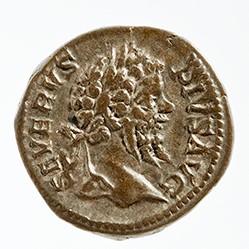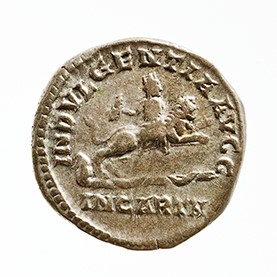Acquisition number: 1966.51
Obv.: Head of Septimius Severus r., laureate, bearded. SEVERVS PIVS AVG(ustus).
Rev.: Dea Caelistis seated r. on a leaping lion and holding a sceptre in her left hand and a thunderbolt in her right. Below, waters gushing from a rock. IDVLGENTIA AVGG(= Augustorum). In exergue, IN CARTH(aginem).
Title: Denarius of Septimius Severus - 1966.51
Acquisition number: 1966.51
Author or editor: Beryl Rawson
Culture or period: Roman Imperial
Date: AD 204
Material: Metal - Silver
Object type: Coins - Roman
Dimensions: 18mm (w)
Origin region or location: Italy
Origin city: Rome
Display case or on loan: 7
Keywords: Coin, denarius, Roman, Imperial, Septimius Severus, Dea Caelestis
Sear, D.R., Roman Coins and their Values 5 vols (London, Spink, 2000-2014) 6285; Seaby, H.A., Roman Silver Coins (London, B.A. Seaby, 1967) III 222; Mattingly, H.,Coins of the Roman Empire in the British Museum, 6 vols (London, 1965) 335-8.
1966.51
Denarius of Septimius Severus
3.373 g. AD 204
Obv.: Head of Septimius Severus r., laureate, bearded. SEVERVS PIVS AVG(ustus).
Rev.: Dea Caelistis seated r. on a leaping lion and holding a sceptre in her left hand and a thunderbolt in her right. Below, waters gushing from a rock. IDVLGENTIA AVGG(= Augustorum). In exergue, IN CARTH(aginem).
Septimius Severus took the name Pius to connect himself with the Antonine dynasty. Cf. on 66.53. The form of the name on the obverse belongs to the period AD 201-210. The specific date for this coin may be AD 204, when Septimius celebrated the Secular Games and gave a special role to the deities of his native North Africa. His birthplace was Lepcis Magna, but the beneficence (indulgentia) recorded here (a new aqueduct? improved water supply?) is to Carthage, of which Dea Caelestis was a goddess.
Caracalla had received the title ‘Augustus’ in AD 198, hence the reverse legend: ‘beneficence of the (two) Augusti’.
Cf. 2007.04
Sear, D.R., Roman Coins and their Values 5 vols (London, Spink, 2000-2014) 6285; Seaby, H.A., Roman Silver Coins (London, B.A. Seaby, 1967) III 222; Mattingly, H.,Coins of the Roman Empire in the British Museum, 6 vols (London, 1965) 335-8.

